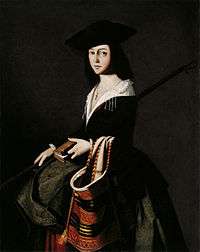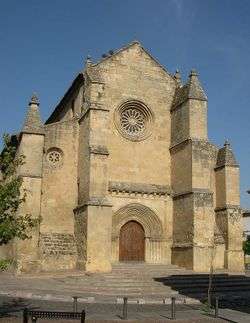Marina of Aguas Santas
Saint Mariña of Aguas Santas (Mariña of Ourense) (119–139 AD) is a virgin martyr associated with the town of Aguas Santas, in the province of Ourense. The story of her life as it has been preserved is a mixture of fact and fiction. She is venerated as one of nine sisters, including Quiteria and Liberata (Santa Librada).
Saint Marina | |
|---|---|
 Santa Marina, by Francisco de Zurbarán. | |
| Born | 119 AD |
| Died | 139 AD |
| Feast | July 18 |
Legend
She is said to have been born in Bracara (today Braga, Portugal) to Lucius Catilius Severus, Roman governor of Gallaecia and Lusitania, and Calcia, his wife. Marina was one of nine daughters. Calcia, frightened that her husband would interpret this multiple birth as a sign of infidelity, ordered her servant Sila to drown the girls in the Miñor River.
Disobeying her mistress, Sila, secretly a Christian, left Calcia's daughters in the care of several families. Marina and her sisters were baptized by the Bishop of Braga Saint Ovidius (Ovid, Ovidio) and brought up in the Christian faith. When they were twenty, they were accused of being Christians and brought before their father the governor. He recognized them as his own daughters, and asked them to renounce their faith, promising them luxuries. St. Quiteria is one of her sisters who also venerated as a saint.
The sisters refused and were imprisoned. They managed to escape and were ultimately martyred for their faith. A spring of water gushed out of the spot where they were beheaded; the spot was called Aguas Santas ("Holy Waters").
Veneration
Marina's legend is similar to another Portuguese saint, the virgin martyr St. Quiteria and it is also believed that St. Quiteria is her sister. Her legend was sometimes also confused with that of Margaret of Antioch, who was sometimes also called Marina. Due to a confusion with the popular figure of Wilgefortis, Liberata is sometimes represented as martyred on a cross.
The saint is no longer included in the Roman Martyrology, but previous versions —Baronius introduced her in the second edition—describe her as: Gallaeciae in Hispania sanctue Marinae virginis et martyris.[1]
The spread of her cult is attested by the fact that many churches were dedicated to her not only in Galicia and Astorga, but also at Córdoba and Seville.[1] The friar and historian Juan Muñoz de la Cueva was an ardent protector of the cult of Marina of Aguas Santas.[2]
Popular devotion traditionally places the date of death for Mariña and Liberata (one of her sisters) on January 18, 139. The feast of Marina is celebrated on July 18. Liberata's feast day is celebrated on July 20, which is the date for the translation of her relics from the city of Sigüenza to Baiona in 1515. Liberata (in Portuguese Livrada) is the patron saint of Sigüenza. The chapel dedicated to her in the transept of the city's cathedral, with a splendid reredos and the relics of the saint, was constructed at the expense of Bishop Fadrique de Portugal.[3]
 Church of Santa Marina, Córdoba.
Church of Santa Marina, Córdoba.- Church of Santa Marina, Mayorga.
References
- ‘Santa Marina di Orense Martire ’, Santi e Beati.
- José María Castroviejo, Galicia: Guía Espiritual de una Tierra (Madrid: Espasa-Calpe, 1960), 340.
- Ramón Ruiz Amadó and Teodoro Rodríguez y Fernández, ‘Sigüenza’, in The Catholic Encyclopedia, vol. 13 (New York: Robert Appleton Company, 1912).
External links
- (in Spanish) Santa Marina at the Spanish Wikipedia
- (in Italian) Santa Marina di Orense